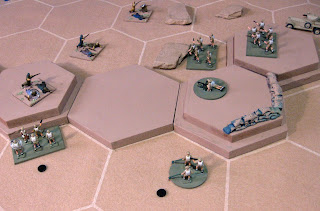Instead of the annual Christmas viewing of Zulu, I decided to have a go at a scenario from the Command & Colors Battlecry map selection; Isandlwana. The map, shown below depicts a scenario where the Zulu army has already deployed the two horns and the main body has come into view:
As can be seen the tactical options for the British are somewhat limited, other than stand and fight. Durnford and his cavalry have already withdrawn back to the main position and the British force is all but surrounded.
This is what the table looked like, viewed from the main Zulu army:
With the right horn:
And the left:
And the British firing line:
The British plan was to pull back the three units out on their left flank and attempt to form a square. The Zulus decided to press on the British flanks to draw off men from the main firing line then deliver a final blow in the centre.
Almost immediately the Zulu right horn poured down off the slopes.
The Zulus sliced into the British left hacking down a number of the soldiers.
As this was going on a similar event takes place on the other flank as the left horn charges into the British infantry and dismounted irregular horse:
The situation looks grim for the British:
However, despite heavy casualties, first the right horn is pushed back:
And on their right the British stand their ground, albeit having been forced back by the left horn and with many casualties:
Now the Zulu main body begins to move forward, however, as the two horns have failed to draw off troops from the firing line the Zulus crossing the river are met by both heavy volley fire and artillery:
The Zulu main body is stopped in its tracks, but the Zulu right horn, having rallied pushes in against a weakened British left flank. The British gunners are wiped out and several more infantrymen fall:
Now under pressure on the left, the British firing line begins to falter allowing the Zulu main body into contact and the situation looks dire for the redcoats. This is the Zulu high watermark.
Successful volley fire and a couple of bayonet charges tips the balance for the British (and some lucky dice rolls!). The Zulu now have reached their exhaustion point with well over 50% casualties. They break off the attack.
The final situation as the much depleted British force holds their position at Isandlwana:
An unexpected result, but a fast and enjoyable action. I must try the Rorkes Drift scenario!



























































